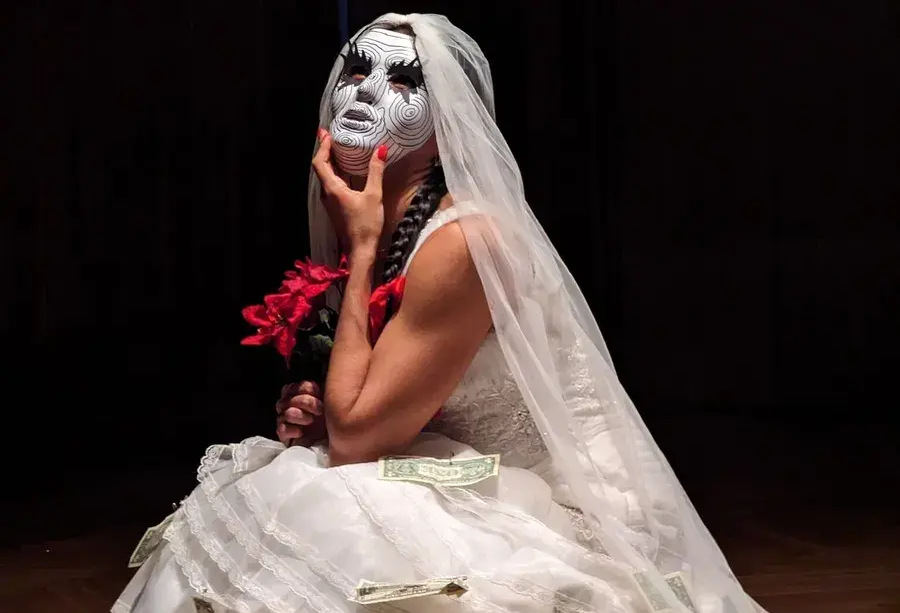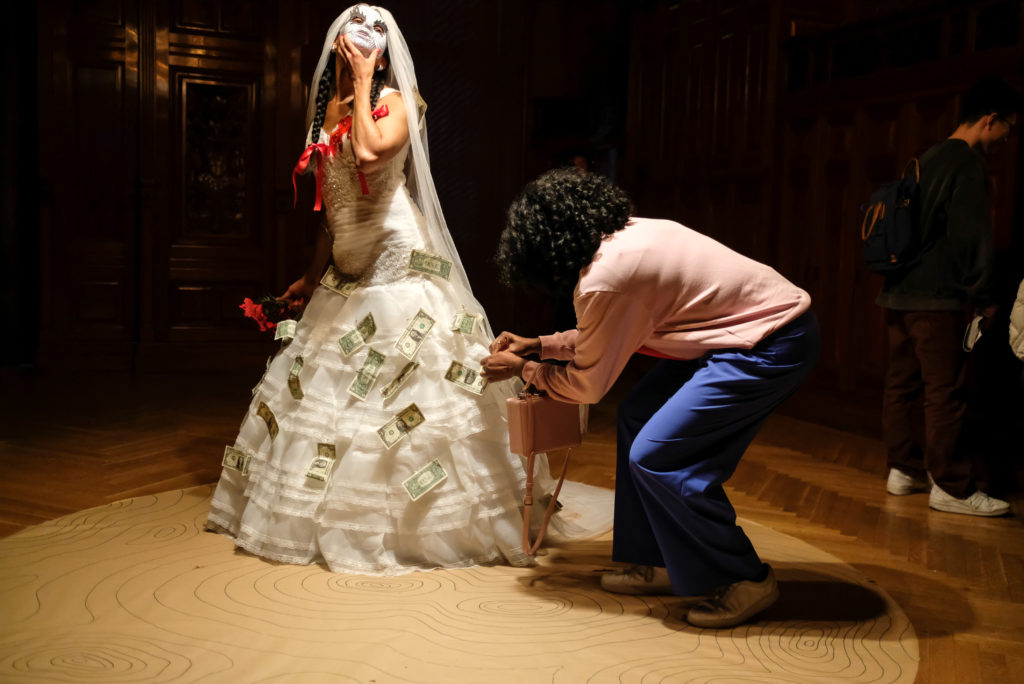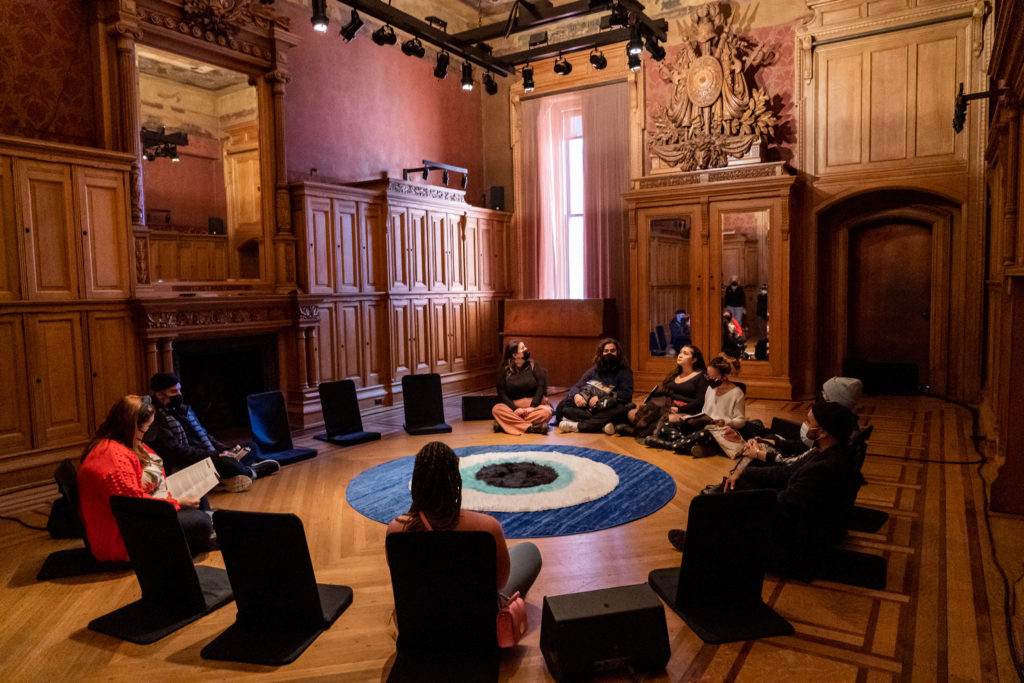What is the role of race in theatrical design? An innovative symposium at the Park Avenue Armory on Jan. 14 and 15 asked visitors to consider the question. As part of the venue’s conversation series, Making Space at the Armory, “Sound & Color: The Future of Race in Design” brought together artists and designers working across the disciplines of costume, lighting, set, and sound for a groundbreaking collaborative enterprise. Curated by the brilliant minds of lighting designer Jane Cox, playwright Branden Jacobs-Jenkins, set designer Mimi Lien, and sound designer and composer Mikaal Sulaiman, the event’s theme was inspired by the song “Future People” from the Alabama Shakes album Sound & Color, on which lead singer Brittany Howard sings, “Some things could be seen from above, thread of design don’t trip me up,” implying that design is about the power of perspective.
The weekend featured engaging conversations, immersive VR exhibitions, and most significantly the presentation of six micro-commissions created by eight emerging designers of color and their collaborators over a 48-hour period. Given the Colonial-era resonances of the Armory—its woodwork and wrought iron, its Gothic Revival design, its elitist history—as both a discussion backdrop and art-making venue, the symposium provided a unique opportunity to explore what it means for designers of color, as the program challenged them, to “Take Space” and “Disrupt with Love.”
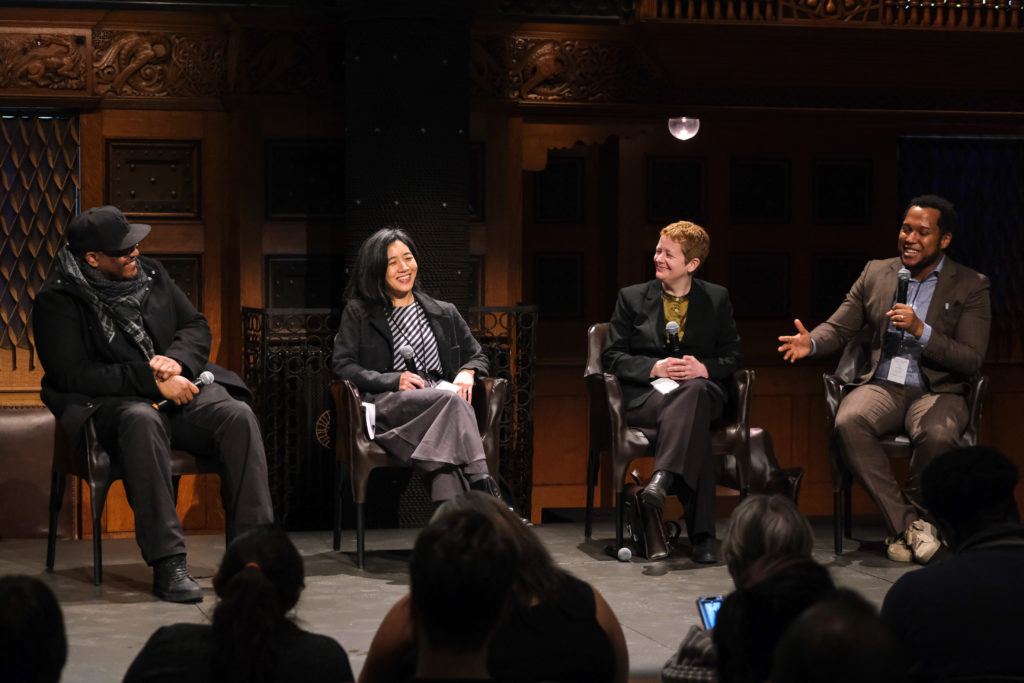
The opening welcome featured an introduction by the Armory’s curator of public programming, Tavia Nyong’o, and a beatbox performance by Chesney Snow, followed by a conversation with the host designers, moderated by Jacobs-Jenkins. The panelists expressed their hope that the symposium would be the first manifestation of a vital and ongoing conversation about the role of race in design. They described the fine line that a designer walks within the field between acting as a translator and a realizer of abstractions. While often included as part of the creative team, designers are still typically considered separate from creative funding, and are usually ineligible for grants and residencies due to the collaborative nature of their work.
Lien spoke about how the technology the industry relies on can hold back progress. There is racism inherent in LED lighting systems, she explained, as they are keyed to flatter lighter skin tones. Design students are typically taught how to center a “pale object in a dark space,” said Lien, calling to mind the theatre’s black-box-as-neutral background aesthetic. This practice sets biased expectations as to who looks best or belongs in the spotlight, when spaces are unequipped to design for all bodies and skin tones.
At the same time, Sulaiman observed that recent improvements in access to software and technology—programs like GarageBand or phone recording devices—have lowered some industry barriers for artists who come from diverse or underrepresented backgrounds. Tools that were once confined to conservatory classrooms are now in the hands of young people, potentially broadening perspectives in the field. Together the host committee raised the question of whether design can be about liberation. This seems possible, if designers of color are given more opportunities to shape the future of theatre.

Members of the design team behind Lincoln Center’s The Skin of Our Teeth came together for a conversation about creating a collaborative aesthetic over time. The panel included costume designer Montana Blanco, set designer Adam Rigg, sound designer Palmer Hefferan, and puppet designer and fabricator James Ortiz, and was moderated by director Lileana Blain-Cruz. They discussed how they have all been able to sustain a culture of care and a collaborative ethos over many years working together, and emphasized the importance of building interdepartmental relationships.
Blain-Cruz explained her motivations behind centering a Black family in Thornton Wilder’s classic play about survival, endurance, and hope. While there was no Better Homes and Gardens equivalent record of African American homes in the 1950s, the designers were able to use photographs, textiles from period clothing, spiritual music, and Afro-Caribbean carvings as inspiration for the production. In designing the play, the team was able to take audiences beyond the “safety of the white patriarchal architecture” and address the show’s themes of humans domesticating nature in parallel, culminating in a third act evoking the Reconstruction era.

Another of the day’s highlights was a meaningful discussion about teaching design and production through an anti-racist lens. The panel featured costume designer and Princeton faculty member Sarita Fellows; head of undergraduate lighting design training at NYU Tisch, Jeanette Oi-Suk Yew; and dramaturg and University of Rhode Island professor Christine Mok. They recognized that education should be a two-way exchange, between what instructors have to offer their students and what students bring to their classrooms. The panelists shared the ways they prioritize skills that will serve students in an imperfect industry, explaining that it is just as valuable for designers to be adept collaborators as independent artists.
“I never lie to my students about the industry’s flaws,” said Oi-Suk Yew. “But I also tell them I wouldn’t want to do anything else.”
Fellows added that professors cannot teach anti-racism simply by reading plays by playwrights of color. She recalled the results of a colleague’s costume rendering assignment, in which all students except one opted not to include skin color as an integral part of their designs. Fellows immediately recognized which design belonged to the one student of color in the room. By failing to include skin color, the other students made whiteness the default. “How do we begin to ask questions of ourselves and put our work forward into the world, knowing we will make mistakes?” Fellows wondered.
She acknowledged that her lessons and assignments are part of a larger department, represented by a curriculum and empowered by an institution. This is why it is necessary for faculty to have educational transparency and look at colleagues’ syllabi to ensure students are set up for success.
The six micro-commissions painstakingly created by eight emerging theatre artists and their collaborators over 48 hours, were presented in the Armory historic rooms in partnership with Design Action, a collective of designers of color and white designers advocating for a radical shift in the landscape of American theatre design. Chosen from a large pool of applicants, the designers were tasked with preparing responses to the question of what it means to “Take Space” and “Disrupt with Love” as young designers of color.
Lighting designers Christina Tang and Alex Vásquez Dheming’s design, [working], dramatized the design process and delivery rather than the product by “creating contemporary, co-spatial experiences that center light, distortion, and competing attentional demands,” for the purpose of “examining the relationships between design, systems, audiences/participants/users, and control versus influence.” Viewers peeked into the exhibit room through partly opened doors as a lighted mobile of multicolored translucent birds hung down from above, gently spinning and casting shadows, while the sounds of nature swirled.
Scenic and costume designer Rodrigo Hernandez Martinez’s Something borrowed, something green explored self-love and community support through the lens of immigration between Mexico and the U.S. in post-lockdown 2020. While an influx of middle- to upper-class U.S. citizens moved to Mexico with their remote jobs, raising the cost of living and displacing locals, Mexican immigrants in the U.S. struggled to stay here without work visas. The design explored the Latin American wedding tradition of guests pinning money to the newlyweds’ attire during their first waltz as a symbol of prosperity and abundance. The exhibit invited viewers to engage with the design by pinning dollar bills to a performer’s costume piece, an elaborate wedding dress and veil that soon became draped in symbols of American greed.
Sound designer Elliot Yokum’s Evil Eye explored the concept of a safe space, juxtaposed with the malevolent gaze and protection evoked by the nazar or achqi ulunk charm in West Asian culture, examining the complicated intersection between queerness and heritage. Yokum’s circular soundscape allowed participants to sit in peaceful togetherness with an evil eye rug positioned in the center.
Designers Danielle DeLaFuente and Nina Field created Crack the Foundation. This design took inspiration from the Armory’s original architecture and history of exclusion, using interactive sculptural and sound elements to decolonize the space through community action. With some string, stone, seashells, and metal rods, visitors were able to add their own contributions to various wind chimes.
Scenic designer Marie Laster and lighting designer DeAnna Howard’s Emergence examined the function of systemic change as it goes beyond the surface level to combat hatred and disrupt the forces of racism. The design featured a central tower, cracked, with its core exposed, giving off a kaleidoscope of colorful light and reflection
Designer Gylanni Carrington’s UNSETTLING used the strong imagery and sounds of the horror genre as a medium for design-driven storytelling, inspired by the Armory’s imposing backdrop. Performer Carecuca (Dania Miguel) was haunted and terrorized by a ghostly presence, set to the sound of frantic violins and heart-pounding rhythms.
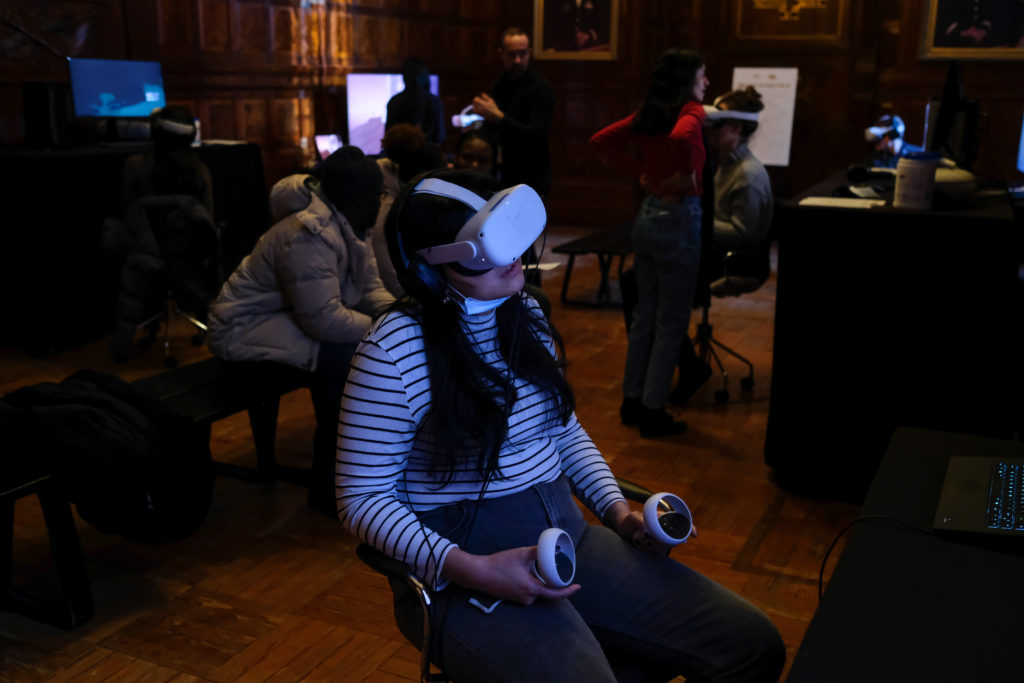
In addition to the micro-commissions, the symposium hosted a selection of ongoing projects. One room displayed elements from the hybrid storytelling work rasgos asiáticos by Virginia Grise and Tanya Orellana, with sound design by Daniel Gower. Another space was devoted to the Black Movement Library’s Movement Portraits VR experience by LaJuné McMillian. The event also featured a VR World Pop Up from Oregon Shakespeare festival’s annual Quills Fest. The Pop Up offered guests the chance to explore a transmedia playground designed to radically expand access to the transformational power of storytelling. It included projects: Anakwad with Ty Defoe, BLOOM by Nao Bustamante, Diagnosia and Loom by Mengtai Zhang and Lemon Guo, Ordinary Gesture by Raja Feather Kelly, Haboob: The Sublime Nature of Sudanese Sandstorms by Neha El-Hadi and Ayodamola Tanimowo Okinseide, and Queerskins: Ark by Illya Szilak and Cyril Tsiboulski.
I wish I could have stuck around for the symposium’s second day, which featured a Black sound artists roundtable, a panel on the future of theatre design in XR (extended reality), a look at Afrofuturism in conversation with design for live performance, and much more.

At the Saturday evening dinner reception, the designers and speakers had the chance to meet and mingle. Networking is a key step in increasing opportunities for emerging designers of color. The hosts wisely tasked established designers in the room with approaching newer artists and making introductions, which alleviated some of the pressure. Designers of all ages and stages expressed their gratitude for the rare opportunity to gather and connect. It’s clear that the conversation around race in design is just beginning, and I for one would be thrilled to see the symposium become an annual tradition.
Alli Pierson (she/her) is associate editor of American Theatre. apierson@tcg.org

